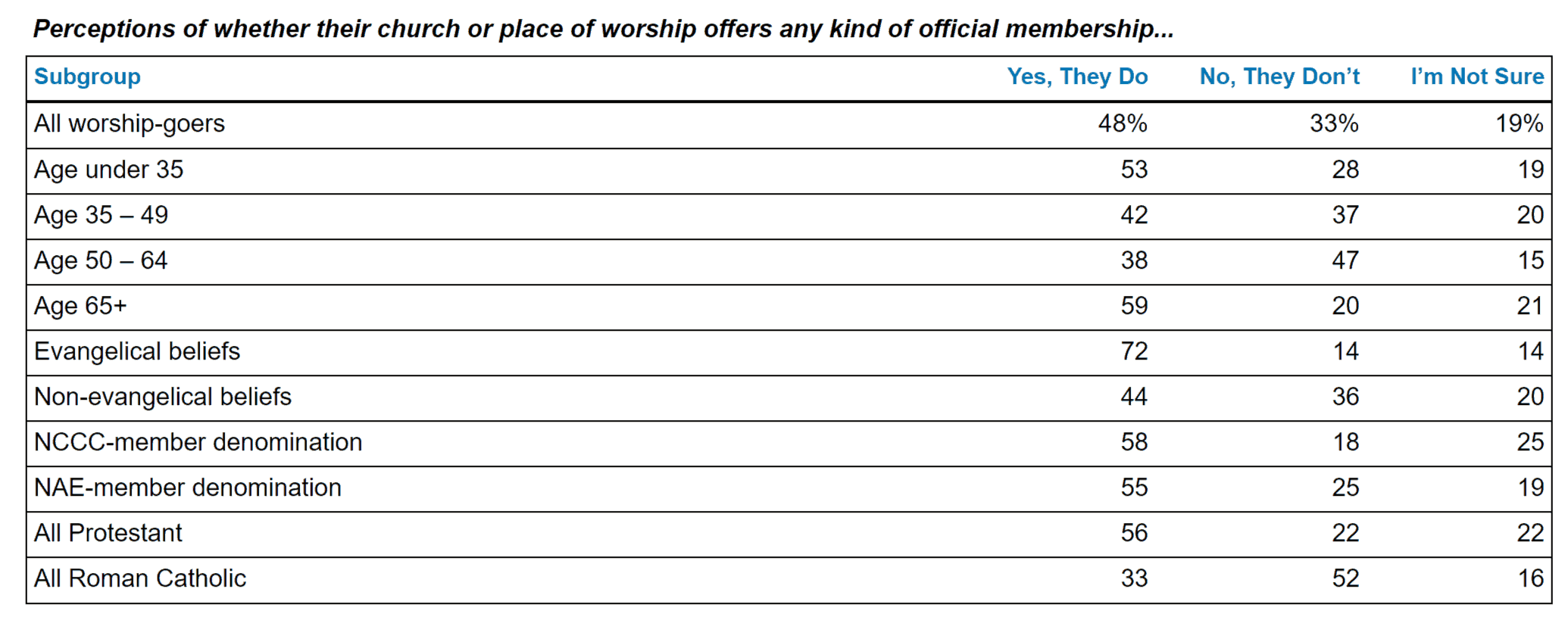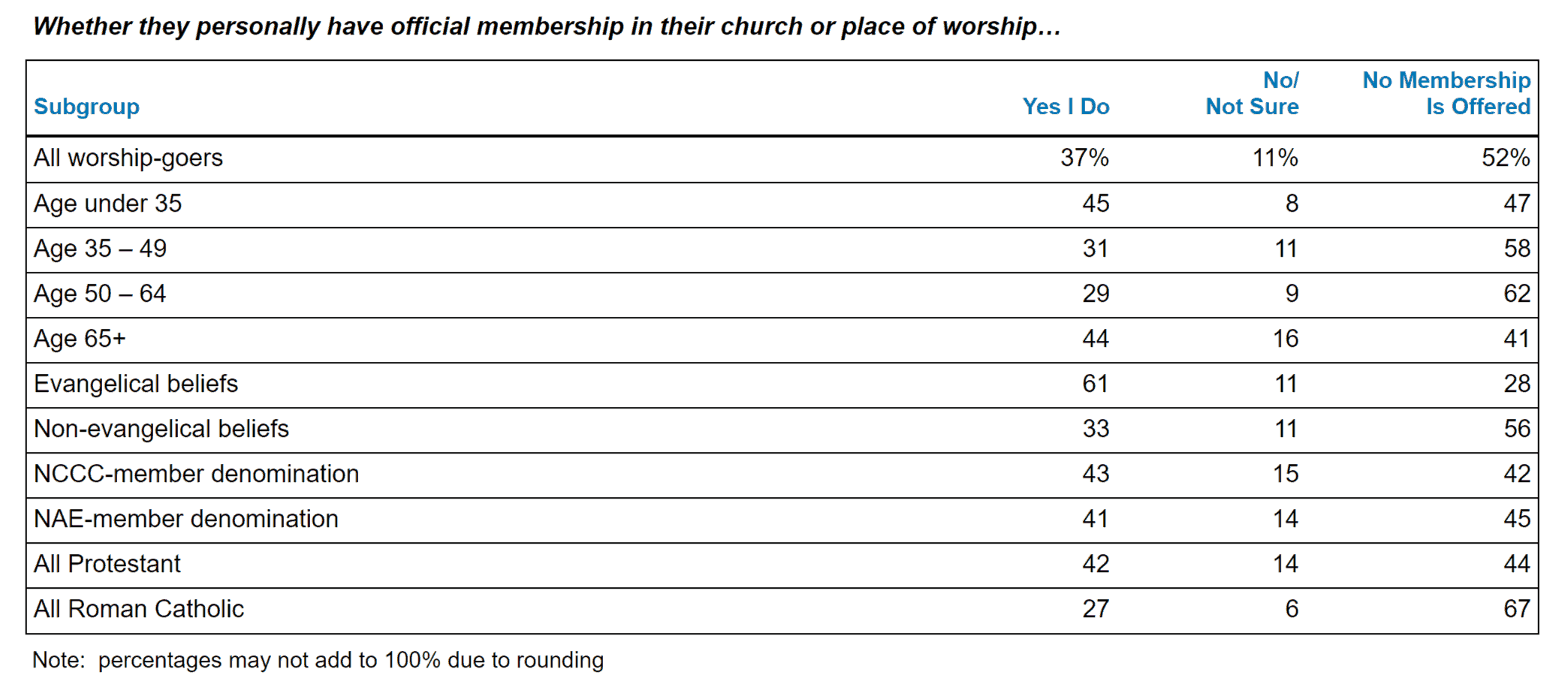Study shows widespread confusion and ignorance on the subject of official membership in a place of worship
(Original release date: August 29, 2012) A new study from Grey Matter Research (Phoenix, Arizona) shows widespread confusion and ignorance regarding official membership in churches and other local places of worship.
The research was conducted among 441 American adults who attend a local church or place of worship once a month or more. The study asked people whether their place of worship offers “any kind of official membership in the organization, or not.” Among all worship-goers, 48% say such official membership is offered, 33% believe it is not, and 19% are not sure.
While some denominations and individual congregations have no official form of membership, most of the largest religious bodies do. All of the ten largest denominations in the U.S. (as measured by the Association of Statisticians of American Religious Bodies) measure some form of official membership: Roman Catholic Church, Southern Baptist Convention, United Methodist Church, Church of Jesus Christ of Latter-day Saints, Evangelical Lutheran Church in America, Assemblies of God, Presbyterian Church U.S.A., Lutheran Church – Missouri Synod, Episcopal Church, and National Baptist Convention USA.
Even so, among people who attend one of these top ten denominations, just 44% say their church offers official membership, while 39% believe it does not, and 17% are unsure.
Perceptions that official membership is available to them are much more common among people attending a Protestant church than among Roman Catholics. Among those in a Protestant church, 56% say their church offers official membership. Only a third of Catholics believe this about their church. In fact, among people attending the nine largest non-Catholic U.S. denominations (all of which offer some form of membership), 69% are aware official membership is offered, just 9% claim there is no official membership available, and 21% are unsure.
The perception that their place of worship offers membership is much more common among older Americans (59%, compared to 45% among people under age 65). Evangelicals are also particularly likely to believe their church offers official membership (72%, compared to 44% among all other worship-goers).
Among people who say official membership is available to them, 78% claim to be members, while 21% attend, but have never become members, and 1% are unsure of their own status.
This means a total of 37% of all regular worship-goers in the U.S. believe they are official members of the place of worship they attend, 10% believe they attend but are not members, 1% are unsure, and 52% are unaware of any official membership offered by their place of worship.
Ron Sellers, president of Grey Matter Research, noted that many denominations continue to measure their size according to official membership, which may not paint an accurate picture of what’s actually happening in the pews. “Under half of all Americans who attend religious services believe they can officially join their church or place of worship,” Sellers noted. “Even when we look just at the largest Protestant denominations that offer membership, about a third who attend are unaware membership is even an option, and about four out of ten people attending those churches claim not to be members. The question has to be asked – how relevant are membership statistics as a measure of denominational size or reach in today’s world?”
Sellers also suggested that many religious groups apparently aren’t doing enough to make membership relevant to people, or to communicate how it is relevant. “Denominational and local church websites often talk about the benefits or importance of membership, but apparently many people just aren’t seeing it as a necessary step in their own spiritual life. Religious groups need to understand why this is, and what can be communicated to people to help explain the relevance of membership.”
An examination of communications from denominations and individual places of worship also often makes membership seem complex and confusing. “Some religious bodies have multiple categories of membership, some talk about ‘membership’ but don’t really define what a ‘member’ is, some denominations offer no official membership even as their local churches do, and each group defines ‘membership’ differently,” Sellers observed. “It’s no wonder so many people are confused.”
Study Details:
The study was conducted by Grey Matter Research, a research and consumer insights company located in Phoenix, Arizona. Grey Matter has extensive experience in research related to faith and spirituality. The sample of 441 adults is accurate to within ±4.6 percentage points at the 95 percent confidence level with a 50 percent response distribution.
The study was conducted in all 50 states using a demographically representative sample from an online research panel. Respondents’ age, education, household income, geography, racial/ethnic background, and gender were carefully tracked and weighted to ensure appropriate representation and accuracy. Non-demographic measures such as religious beliefs and denominational representation were also compared to national norms to confirm representativeness.


